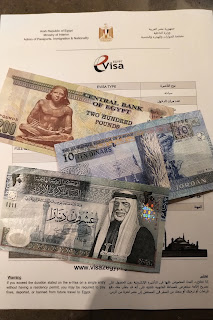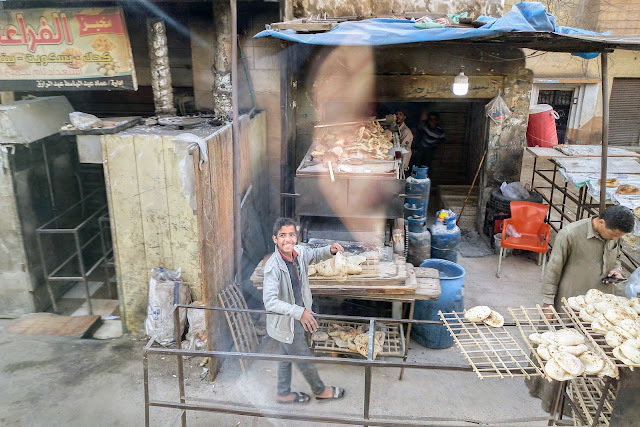Esna Temple
Monday, March 1: Esna Temple and Luxor
This morning, we walked from the ship through part of the town of Esna. Akram led us via short 'touristic market’ and then through a local neighborhood in a very old part of the town. We saw only a handful of non Egyptians there. Locals, mostly men, were in small cafes having their morning conversations. Others were in tiny shops or behind open air stalls selling goods and produce.
One older fellow was using an very large and very old iron to press clothes. On the steps of a mosque, a couple men sat chatting, one smoking his hookah. Under some cloths, suspended above the ground, some kind of meat hung, aging and letting the blood drip away. Three women in traditional moslem attire sat by the road chatting and joking. Few children were around, except for a couple too young to attend school.
Some citizens of Esna
A couple shops had big sacks of cotton balls right off the plants. Others had stacks of old mattresses. These would be opened up and any cotton stuffing within would be reprocessed for future use.
The streets were gravel and dry dirt. Akram explained that the town was having problems with the water table level which was making areas of the town unstable. One abandoned 2nd storey addition to a house listed badly above its single storey neighbours.
Minaret in the older part of Esna
Our group was accompanied by a very quiet security guard. He wore a leather jacket and carried an old automatic rifle slung over his shoulder. I don’t think he was needed; it wasn’t crowded and no one hassled us.
The temple, built during the Greco-Roman period, is a simple rectangle with only a single main room filled with columns. It is situated some 18 metres below street level, almost at the same level as the Nile water. Water table issues are a concern here, too. The original painting on the walls, ceiling, and columns is being cleaned of years of soot from the oil lamps used for lighting. The cleaned areas display vibrant colours that have lasted over 2000 years. Since this temple was almost buried when discovered, it is likely that other ruins or ancient structures are underneath different parts of the town.
Pharaoh making an offering to the gods.
Temple interior, above
The outer walls of the temple show some well-done images carved into the wall stones. The captain cast off when we returned for to complete the rest of the voyage to our final port of Luxor, passing though one large lock which lowered the ship 6 or 7 metres. Once we tied up in Luxor, we went walking along a main street that was definitely not a ‘tourist’ street. I don’t think we saw any other visitors besides us as we wandered along, looking at (and smelling) the bakeries.
The rest of the day was spent getting organized and packing for our morning flight back to Cairo.
Some buildings look unfinished on the upper levels. The lower levels are inhabited and the upper levels are there in case more family needs a place to live. Then, the top floor is completed. This view is from the ship's dining room on the lowest deck, its windows not much above water level.
At busy times, the cruise ships have to have to resort to rafting, tying up beside each other. Passengers have to pass through neighbouring ship lobbies to get to shore.
As we approached the lock and slowed, small boats came alongside trying to sell merchandise to passengers.


















Comments
Post a Comment